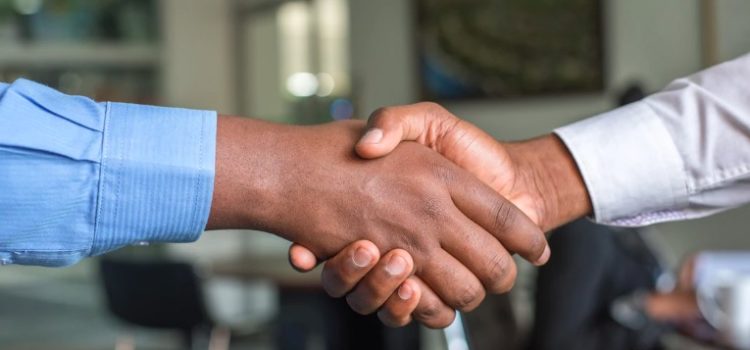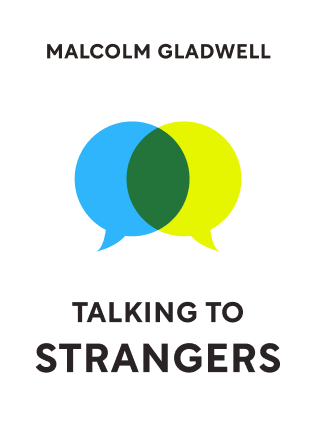

This article is an excerpt from the Shortform book guide to "Talking to Strangers" by Malcolm Gladwell. Shortform has the world's best summaries and analyses of books you should be reading.
Like this article? Sign up for a free trial here .
In our modern, seemingly borderless world, we have no choice but to interact with strangers. Yet we, as a society, are incompetent at making sense of the strangers we come across. So what should we do? Can we learn how to talk to strangers?
We’ll discuss the three problems that cause us to have failed interactions with strangers and discuss how to talk to strangers in ways that are more successful. From Malcolm Gladwell’s Talking to Strangers.
How to Talk to Strangers
If our society is to avoid failed interactions between strangers, we must learn to:
- Stop penalizing people for the human instinct to default to truth (like blaming the viewers in the Trivia Experiment for not being able to spot a liar).
- Understand that there is no perfect strategy for interpreting a stranger’s thoughts and intentions (like using Amanda Knox’s behavior as an indication of her guilt).
- Be careful and attentive when speaking to a stranger (don’t jump to conclusions about someone based on thin evidence, like Brian Encinia did).
Most importantly, we must learn not to blame the stranger when an encounter goes awry, but to look into how our own instincts might have played a part, as well. This is how to talk to strangers.
How to Speak to Strangers
In today’s society, people often find themselves in encounters with complete strangers. Judges have to grant or deny a stranger’s freedom. College students meet a stranger at a party and have to decide whether to give out their phone number. People invest large sums of money based on a total stranger’s recommendations.
This book is about why we are so bad at understanding the strangers we come across. By looking at stories from world history and recent news, you’ll begin to understand the strategies people use to translate the words and intentions of strangers. You’ll learn where those strategies came from. And, you’ll begin to notice how those strategies ultimately fail.
Two Puzzles
There are two major puzzles about how to speak to strangers that this book will attempt to answer.
- Why can’t we identify when a stranger is lying to our face?
- Why does meeting a stranger face-to-face sometimes make it harder to make sense of that person than it would be without meeting them at all?
Three Answers
The problem at the heart of the two puzzles is that people assume that they can make sense of others based on relatively simple strategies. But when it comes to how to talk to strangers, nothing is as simple as it seems.
There are three major strategies that people use to make sense of and talk to strangers:
- People default to truth.
- People assume transparency.
- People neglect coupled behaviors.
These three strategies ultimately fail because they operate under the assumption that simple clues are enough evidence of a stranger’s internal thoughts or intentions. We will look at each of these strategies separately to see where they came from and why they often result in failed interactions when talking to strangers.
Flawed Strategy 1: People Default To Truth
The primary reason that most people can’t immediately identify when a stranger is lying is that human beings default to assuming truth in others.
Truth-Default and How It Works
Truth-default is important in understanding how to talk to strangers. To understand and analyze the Truth-Default Theory, psychologist Tim Levine used hundreds of versions of the same basic experiment (referred to here as the Trivia Experiment). Here is how the Trivia Experiment works:
- Levine invites participants to a laboratory. They are told that if they can answer a trivia test correctly, they will win a cash prize.
- Each participant is given a partner. The participants don’t know that the partner works for Levine.
- The test is administered by an instructor named Rachel. The participants don’t know that Rachel also works for Levine.
- Halfway through the test, Rachel leaves the room. The partner points to an envelope lying on the table and asks the participant if they should cheat on the test. The participant is given the opportunity to choose whether or not to cheat.
- After the trivia test is over, Levine interviews the participant on tape. He asks the participant if they cheated during the test.
- After the completion of the interviews, Levine goes back to watch the tapes and categorizes them into two categories: Liars and truth-tellers.
- Other people then watch the interview tapes and try to decipher which participants are lying about cheating and which participants are telling the truth.
Levine’s conclusion was this: When watching the tapes, most people will guess that each person interviewed is telling the truth, unless they see a behavior that distinctly makes them think the person is lying. In other words, the viewers default to assuming truth—they naturally operate under the assumption that the majority of participants are honest. This is the Truth-Default Theory (TDT). Sometimes, this gets in the way of understanding how to talk to strangers.
Is Truth-Default Beneficial?
Ultimately, Levine concluded that human beings do not need to identify lies (from a survival standpoint) as much as we need to be able to have efficient communication and trusting social encounters.
He argues that truth-default is highly advantageous to survival because it allows for effective communication and social coordination. From an evolutionary standpoint, being vulnerable to deception does not threaten human survival, but not being able to communicate (the result of being skeptical of others’ honesty) does threaten human survival.
Truth-Default Example: The CIA
The CIA is supposed to be the most sophisticated intelligence agency in the world. But even some of the best CIA agents have failed to detect liars in their midst.
During the Cold War, Aldrich Ames, one of the most senior officers in the CIA’s Soviet Counterintelligence agency, was working as a double agent for the Soviet Union. Years later, one of the most highly-respected agents in the CIA, known as the Mountain Climber, said he had always held a low opinion of Ames. But the Mountain Climber never suspected Ames as a traitor—he defaulted to trusting Ames.
If the Mountain Climber, one of the best agents at one of the most selective agencies in the world, can’t pick out a liar among his own team of spies, how can the average person be expected to be able to catch a total stranger in a lie?
Flawed Strategy 2: Assumed Transparency
The primary reason that meeting a stranger face-to-face sometimes makes that person harder to understand is that people assume a stranger will be transparent—that he will present himself outwardly in a way that accurately represents his inner feelings or intentions. But that is not usually the case. This makes it hard to learn how to speak to strangers.
Transparency and How It Works
Humans are not transparent—it’s all a myth. Because we have all watched the same TV shows and read the same novels where a character’s “jaw drops in surprise,” we have been conditioned to believe that there is one expression associated with any particular emotion. But that is unrealistic.
In reality, it takes getting to know someone well to be able to see through them. With a close friend, you come to understand their idiosyncratic expressions and what they mean to express. But when you encounter a stranger, you often have to make assumptions based on their expressions, because you don’t have any personal experience with that person. But your assumptions are based on stereotypes, like a jaw dropping in surprise, that are usually wrong. This is a reason it’s hard to know how to talk to strangers.
After the Trivia Experiment, Tim Levine felt as though there had to be another reason (besides Truth-Default) that people tend to mistake lies for the truth. In an effort to explain this pattern, Levine returned to the tapes of his Trivia Experiment participants.
Two of Levine’s participants were particularly interesting to study. Let’s call one Sally and the other Nervous Nelly.
- When asked if she cheated, Sally took a lot of pauses, started to blush, avoided eye contact, and appeared confused. Every viewer who watched Sally’s interview accurately identified that Sally was lying.
- When asked if she cheated, Nervous Nelly gave rambling answers, obsessively played with her hair, became defensive, and acted agitated. Every viewer who watched Nervous Nelly’s interview suspected that Nelly was lying. But Nelly was telling the truth.
The viewers were operating under the assumption of transparency that someone who behaves like a liar is indeed a liar. For example, Sally matched—she was being dishonest and she was acting dishonest.
In other words, the average person is only bad at detecting lies when the sender is mismatched. For example, Nervous Nelly mismatched—she was being honest but her demeanor seemed stereotypically dishonest. Mismatching confuses the average person—it is at odds with the natural assumption of transparency. This is a roadblock in understanding how to talk to strangers.
Assumed Transparency Example: Amanda Knox
On November 1, 2007, an American college student named Meredith Kercher was murdered in the small, Italian town of Perugia. Kercher’s body was found by her roommate, Amanda Knox. Knox called the police to the scene of the gruesome crime. Knox was ultimately convicted for the murder of Meredith Kercher.
What doesn’t make sense is why Amanda Knox convicted, or even suspected. There was no physical evidence or motive that linked her to the crime. The simplest theory of what went wrong with Amanda Knox’s case is this: the police expected Knox to be transparent and she wasn’t. Her case is an example of the consequences of assuming that the way a stranger looks is a reliable indicator of how she feels.
Amanda Knox was innocent. But in the months following the crime, the way she acted made her seem guilty. She was mismatched, like Nervous Nelly, drawing suspicion from investigators. Here are a few examples of how Amanda Knox behaved after Meredith Kercher’s murder:
- The police told Amanda to put on protective booties before walking through the crime scene. She did so, and then struck a pose and said “ta-dah.”
- When Kercher’s friend Sophie attempted to hug Amanda and express sympathies, Knox just stood with her arms at her sides and remained expressionless.
- While most people were crying and speaking in hushed tones around Meredith Kercher’s family, Amanda Knox and Raffaele Sollecito were cuddling up with each other, kissing, and even laughing.
So Amanda Knox spent four years in prison (and another four years waiting to be declared officially innocent) for the crime of behaving unpredictably—for being mismatched. But being weird is not a crime.
Flawed Strategy 3: Neglect of Coupled Behaviors
The third mistake that people often make when talking with strangers: We fail to recognize coupled behaviors, behaviors that are specifically linked to a particular context. For example, we fail to see how a person’s personal history might affect his behavior in a particular environment. Instead, people tend to operate with an assumption of displaced behaviors, behaviors that do not change from one context to the next.
Once you understand that some behaviors are coupled to very specific contexts, you’ll learn to see that a stranger’s behavior is powerfully influenced by where and when your encounter takes place. Then, you’ll be able to recognize the full complexity and ambiguity of the people you come across.
Coupled Behavior Example: Crime
In the early 1990’s, the Kansas City Police Department decided to study how to deploy extra police officers in an effort to reduce crime in the city. They hired criminologist Lawrence Sherman and gave him free rein to make changes in the department. Sherman was sure that the high number of guns in Kansas City was coupled with the city’s high level of violence and crime. So he decided to focus his experiment specifically on guns in the 144th patrol district of Kansas City, one of the most dangerous areas in the city.
In an effort to focus on the coupled behaviors of gun ownership and crime, Sherman deployed four officers in two cars to patrol District 144 at night. He told these four officers to watch out for any suspicious-looking drivers and pull them over. The officers were told to search as many cars that fit the specific requirements and confiscate as many guns as possible. These officers were effectively searching for a needle in a haystack. The ultimate goal was to find a gun or drugs. The four officers in Sherman’s experiment went through specialized training and only worked in District 144 at night—Sherman wanted to make sure that they knew how to target the right kind of traffic stops, in the right kind of locations, at the right times, that led to the right kind of searches.
Over the 200 days that Sherman ran his experiment, gun crime was cut in half in District 144 of Kansas City. The experiment was successful because it made crime-fighting strategies more focused—it targeted one aspect of the coupled behavior (guns) in order to prevent the other coupled behavior (crime).
A Failed Interaction Between Strangers
Even though learning how to talk to strangers is difficult, it’s an imperative skill in today’s world.
On July 10, 2015, a young woman named Sandra Bland was pulled over in a small town in Texas for neglecting to signal a lane change. The police officer’s name was Brian Encinia. His interaction with Sandra Bland began courteously enough. But after a few minutes, Sandra lit a cigarette and Encinia asked her to put it out. She refused, and the interaction dissolved from there.
Brian Encinia told Sandra Bland to step out of the car. She repeatedly said no, telling the officer that he had no right to ask that of her. Eventually, Encinia began to reach into the car and try to remove Sandra by force. Finally, Sandra stepped out of her vehicle. She was arrested and put in jail, where she committed suicide three days later.
Sandra Bland’s arrest and subsequent suicide in jail is a tragic example of what can happen when two strangers use flawed strategies to try and understand each other. This is the tragedy of not understanding how to talk to strangers.
Encinia’s Three Mistakes
In dealing with Sandra Bland, officer Encinia used the same three strategies that most people would make when dealing with and knowing how to talk to strangers:
- Truth-Default: Brian Encinia was taught, through his police training, not to default to truth. He was taught to treat everyone like a suspect. And (because the cost of not defaulting to truth is to have mistrusting social interactions) Encinia was immediately scared of Sandra Bland
- Assumed Transparency: When Bland acted irritated and defensive about being pulled over, Encinia automatically began to assume the worst. In his testimony, Encinia said that he “immediately” knew that there was something “wrong” about Bland, based on her demeanor. He felt afraid that she was “aggressive,” and even suspected she might have a gun.
- Neglect of Coupled Behaviors: Sherman’s experiment showed that the needle-in-a-haystack approach only works when it is focused on particular contexts, like high-crime areas or gun ownership. The area of Prairie View where Brian Encinia pulled Sandra Bland over was not a high-crime environment. But Encinia never stopped to consider that the likelihood of Bland committing a crime was coupled with the time and location of their interaction.
Understanding how to talk to strangers can be a minefield, but it’s something we should all attempt to get better at. Keeping these mistakes in mind can help.

———End of Preview———
Like what you just read? Read the rest of the world's best book summary and analysis of Malcolm Gladwell's "Talking to Strangers" at Shortform .
Here's what you'll find in our full Talking to Strangers summary :
- Why we don't understand strangers
- How to talk to strangers in a cautious way so you don't get fooled
- How Hitler deceived so many world leaders






